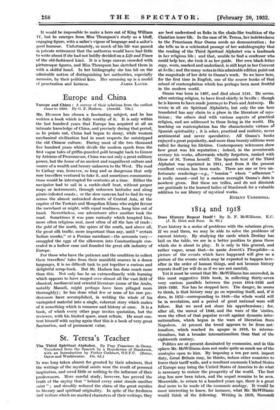St. Teresa's Teacher
'IT was long taken almost for granted by their admirers, that the writings of the 'mystical- saints were the result of perional ' inspiration, and owed little or nothing to the influence of their 'predecessors. More careful study, however, has proved- the 'truth of the saying that "behind every saint stands-another saint " ; and steadily reduced the claim of the great mystics to literary and spiritual originality. In spite of the-freshness ' And realism which are Marked characters of their'ritings, they
are best understood as links in the chain-like tradition of the Christian inner life. In the case of St. Teresa, her indebtedness to the Franciscan friar Osuna needs no demonstration ; for she tells us in a celebrated passage of her autobiography that the reading of the Third Spiritual Alphabet was a landmark in her religious life ; and that, unable to find a confessor who could help her, she took it as her guide. Her own black-letter copy, worn, marked and underlined, is still kept in her Convent at Avila ; and the many notes in this admirable edition point out the magnitude of her debt to Osuna's work. So we have here, for the first time in English, one of the source books of that school of contemplation which has perhaps been most fruitful in the modern world.
Osuna was born in 1497, and died about 1541. He seems, after entering religion, to have lived chiefly in Seville ; though he is known to have made journeys to Paris and Antwerp. He wrote in all six Spiritual Alphabets, but only the one here translated has any claim to a place in the literature of mys- ticism ; the others deal with various aspects of practical religion, and are addressed to those living in the world. His teaching on contemplation has the characteristic virtues of Spanish spirituality ; it is sober, practical and realistic, never sentimental and never speculative. All Osuna's books enjoyed a great popularity, and more than twenty editions were called for during his lifetime. Contemporary references show how great was- his reputation ; indeed, in the seventeenth century his works, afterwards wholly forgotten, ranked with those of St. Teresa herself. The Spanish text of the Third Alphabet was reprinted in 1911, and from it the present excellent version has been made. There are one or two un- fortunate renderings—e.g., " tension " where " adherence " is really meant—and by a curious oversight Osuna's date is nowhere given. But these are trifles, and do not diminish our gratitude to the learned ladies of Stanbrook for a valuable addition to our library of mystical works.
EYELYN UNDERHILL..






































 Previous page
Previous page